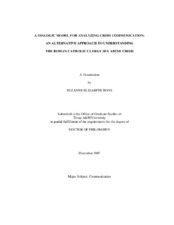| dc.description.abstract | In the winter of 2002, The Boston Globe published an exposé on clergy sexual abuse in
the Boston Archdiocese which quickly sparked a global Church crisis. Following the
exposé, there was a swell of media attention, a growing public outcry, increasing
litigation over alleged abuse and cover-ups, and the emergence of issue-driven
grassroots organizations. Despite the vocal involvement of numerous stakeholders in the
crisis, the hierarchy’s communicative response to the situation followed relatively
traditional crisis management strategies which sought to deny, minimize, remediate, and
retain exclusive jurisdiction over the crisis. This strategy contrasts with other
stakeholders’ attempts to defer closure, draw out underlying issues, amplify nondominant
voices, contest dominant interpretations, and collaborate on possible solutions.
What has emerged is an on-going situation in which an organization’s attempts at
strategic communicative crisis management are being contested publicly by key
stakeholders.
Arguing that existing models for understanding public relations discourse are
insufficient for tracing the polyvocality of crisis communication, this study crafts an
alternative (i.e., dialogic) model for analyzing crisis communication. This model decenters the source organization by tracing the contextual (macro) and interactive
(micro) aspects of public relations texts created by three organizations central to the
crisis (the United States Council of Catholic Bishops, Voice of the Faithful, and
Survivors Network of those Abused by Priests).
By viewing crisis communication through the lens of a particular notion of
dialogue (i.e., a sustained, symbol-based, contextualized, collaborative-agonistic process
of interactive social inquiry which creates meaning and a potential for change), this
study traces how organizations use Public Relations (PR) to co-construct an
organizational crisis. Discursive reconciliation, the central process of the proposed
model, allows the researcher to sift the discourses of stakeholder organizations against
one another, using each as a standard for evaluating the others. This allows for an
evaluation of how stakeholder organizations manage the potential for communicative
interactivity. The proposed model offers an expanded capacity to understand how crises
are constructed discursively. It also illuminates the continuing clergy sex abuse crisis. | en |


